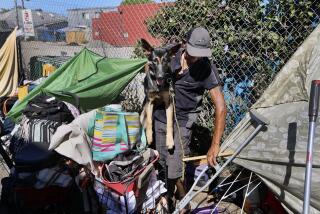Homeless cleanups in L.A. have surged, costing millions. What has been gained?
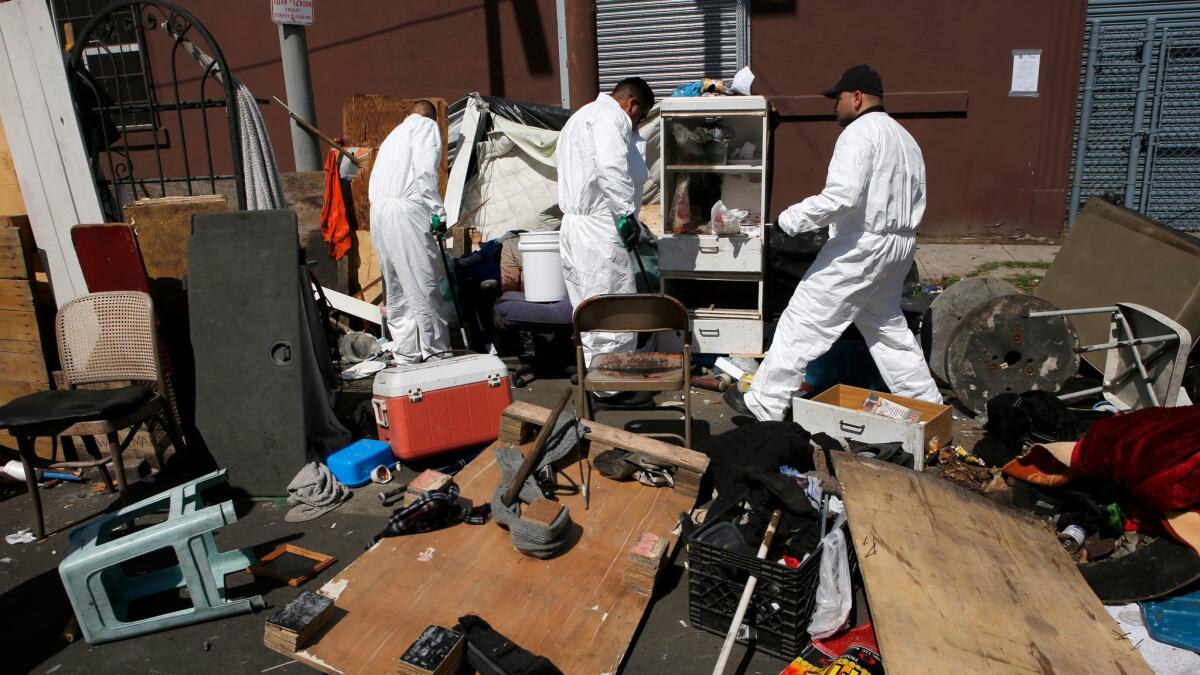
Los Angeles public works crews have cleaned 16,500 homeless encampments since 2015, removing more than 3,000 tons of trash.
But the $14-million citywide cleanup effort — increasing dramatically since it was launched — has made only a marginal difference in the number of encampments across the city’s sidewalks, alleys and riverbanks, a Los Angeles Times review found.
Inspectors for the city’s CleanStat program recorded 365 blocks with encampments at the end of last year, a 12% decline from the beginning of 2016. But other records suggested that after being cleaned, hundreds of encampments simply re-formed elsewhere, usually nearby. Meanwhile, the city reported an 18% increase this year in those living on the streets.
Driven largely by complaints, the cleanups have become recurring dramas in areas favored by homeless campers — frustrating some residents who mistakenly may think that the city’s goal is to evict the street dwellers.
Officials say it is only incidental that homeless people are displaced by the cleanups, which increased seven-fold last year over 2015. The increase effectively established a new city service — trash collection for people who live outdoors.
While residents and business owners may argue that the encampments should be permanently removed, legal settlements obtained by homeless advocates prevent city officials from confiscating homeless people’s tents and other personal property, or evicting those who have nowhere else to go.
With those constraints, public health officials define their purpose narrowly as protecting public health and safety, and follow a stringent protocol to ensure that street dwellers can remove their valuables before the crews arrive.
Public works officials defended city’s spending on the homeless cleanup effort, even though its impact may be hard to see.
“What might have happened had we not spent that money?” said Kevin James, president of the Board of Public Works. “Who might have ended up in an unsafe situation because of hazardous material or where someone is forced to walk into the street? … The money is well-spent.”
But some business owners wondered if the city’s efforts have been futile as they watch the steady carousel of homeless people who are moved from boulevard medians and beneath freeway overpasses only to return in days or weeks.
“[Work crews] clean up and they come right back,” said Joreen Chism, owner of LBI’s Platinum Shears hair salon in North Hills. “It’s just a never-ending cycle. You’d think they would come and find a place for them, but they don’t. They just tell them to move.”
[Work crews] clean up and they come right back. It’s just a never-ending cycle.
— Joreen Chism, owner of a North Hills hair salon, referring to the nearby homeless encampments

A $14-million citywide cleanup effort has made only a marginal difference in the number of encampments across the city’s sidewalks, alleys and riverbanks, a Los Angeles Times review found. Los Angeles public works crews remove a homeless encampment
Around the corner from the salon, more than 140 cleanups have been conducted along Nordhoff Street near the 405 Freeway — among the most in L.A. for a single area, records show.
Citywide, nearly a quarter of homeless encampment cleanups occurred within 500 feet of a freeway, many along the 405 in the San Fernando Valley, the 101 in Hollywood and the 110 in South L.A.
On a chilly morning in early May, Jeannine Tantin, 50, was packing her tent below the 405-118 freeway interchange in Mission Hills. The previous night, she had slept in a nearby underpass where crews have conducted more than a dozen cleanups. She said she usually moves her belongings before cleanup crews arrive, and often returns to the area for the shelter.
“They don’t really clean an area,” Tantin said. “They just take people’s stuff.”
Public Works Commissioner Heather Repenning said even if homeless people return to the same locations after cleanups, those areas are safer overall because of the city’s work.
“Part of the homeless crisis is managing people who are living outdoors, and part of managing that is making sure the basic public health levels are met and that people have outreach done to them so they can know how to access services,” Repenning said.
Multiple pleas for service
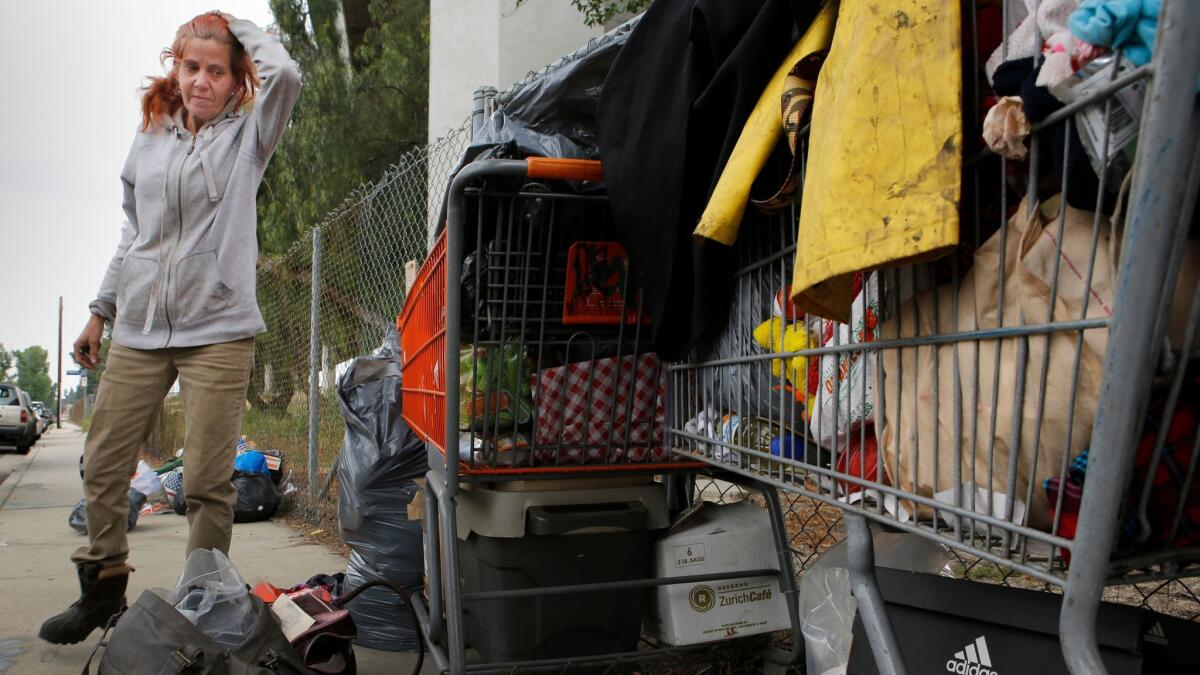
Some in the city frequently report homeless encampments, hoping the city will clean up the areas that often become sullied with litter and human waste.
Teri Markson, senior librarian at the Panorama City branch, has called the city’s 311 line multiple times to request that encampments be cleared from the east side of the library. She has also called the local council office and the Los Angeles Police Department for assistance in the neighborhood where crews have completed nearly 500 cleanups.
“I do it all. Whoever gets here first,” she said.
After weeks of calls and emails, city crews removed encampment structures and carts near the library in April, but Markson arrived to work two weeks later to find a new encampment next to the building.
“Every library has an open-door policy. Our issue is not having them use the library; it’s the camping,” she said.
One piece of homelessness initiative
The cleanups are part of a $100-million effort promised in 2015 to address the increase of homelessness in L.A., a problem that officials described as a “state of emergency.”
Since then, city voters have approved a $1.2-billion bond to speed the construction of housing for the homeless, and county voters approved a quarter-cent sales tax increase to raise $355 million a year to fund a 10-year plan to reduce homelessness. But cleanups will most likely continue for years before those efforts take hold.
When the cleanup effort started in 2015, areas where many of the city’s homeless inhabitants reside — such as the Arroyo Seco, Tujunga Wash and countless alleyways and sidewalks — hadn’t been cleared of garbage and bulky items for years, neighbors said.
City crews caught up with a backlog last March, recording 429 cleanups in a single day. Some locations have been cleaned repeatedly.
Councilman Jose Huizar’s downtown district, which includes skid row, led the city with nearly 900 tons of trash, according to the sanitation bureau.
What goes into each cleanup
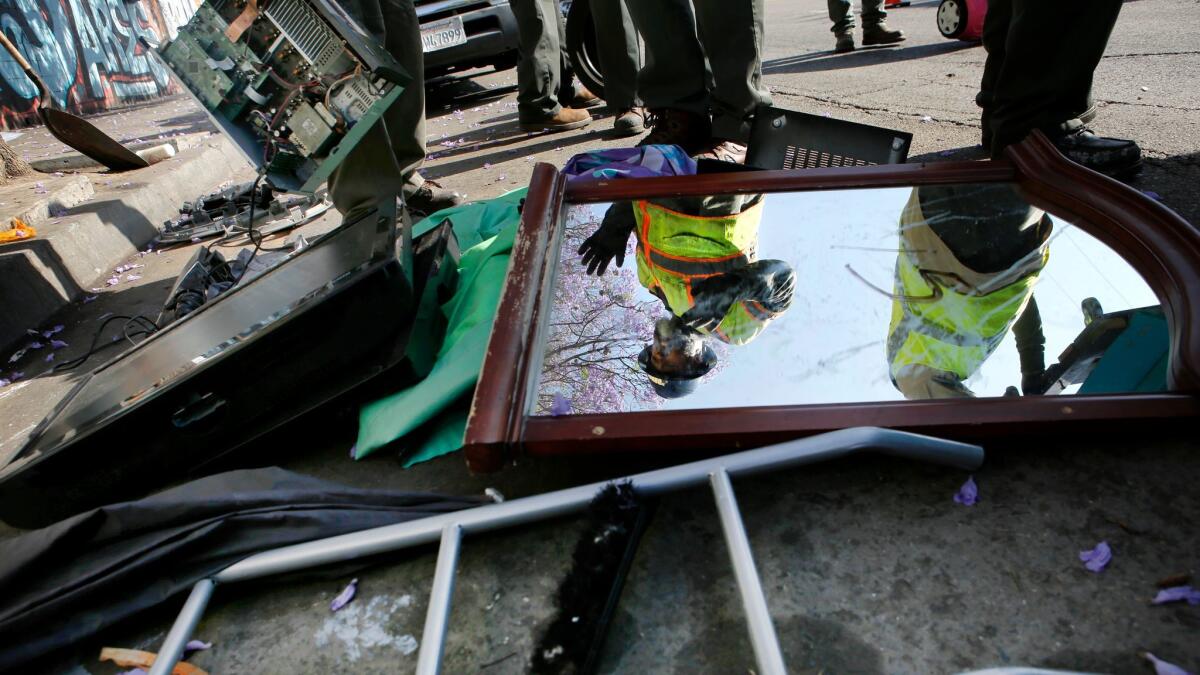
The process usually begins when someone submits a request by calling 311 or using the MyLA311 app. City sanitation workers scout the site to verify the existence of an encampment and then schedule it for cleanup, which occurs on average two weeks later, city data show.
Signs are posted 72 hours in advance to inform homeless people of the pending sweep. Outreach workers from the L.A. Homeless Services Authority visit the location to encourage residents to seek housing and treatment services.
On cleanup day, large trash trucks rumble down the street, accompanied by biowaste teams in white suits. Police officers are there in case anyone resists, something that officials said is rare.
The protocol requires sanitation workers to provide each homeless person with a 60-gallon plastic bag to fill with belongings. If there’s too much personal property to fit in the bag, the remainder must be tagged and transported to a downtown storage facility to be held for 90 days. Often that doesn’t happen.
“The majority are gone before we get there,” said Leo Martinez, who oversees homeless encampment cleanup for the city Sanitation Bureau. “There is very little resistance and very little interaction.”
Shopping carts are classified as trash and loaded along with mattresses, chairs, tarps and other items left behind.
Drug paraphernalia, crude weapons and wooden pallets could be seen at one recent spot. A piece of plywood at an abandoned South L.A. camp was scrawled with the message: “This just ain’t no tent. It’s my home.”
Crews use rakes and shovels to remove items, being careful to avoid contaminated needles or other hazards, said sanitation Supt. Russell Zamora.
“I always tell my group don’t touch anything with your hands because you may think it’s just a pile of trash, but there may be a needle right in there,” Zamora said.
After collecting any material that appears contaminated for separate disposal, the biowaste team sprays the area with disinfectant.
Case study: South L.A. cleanup
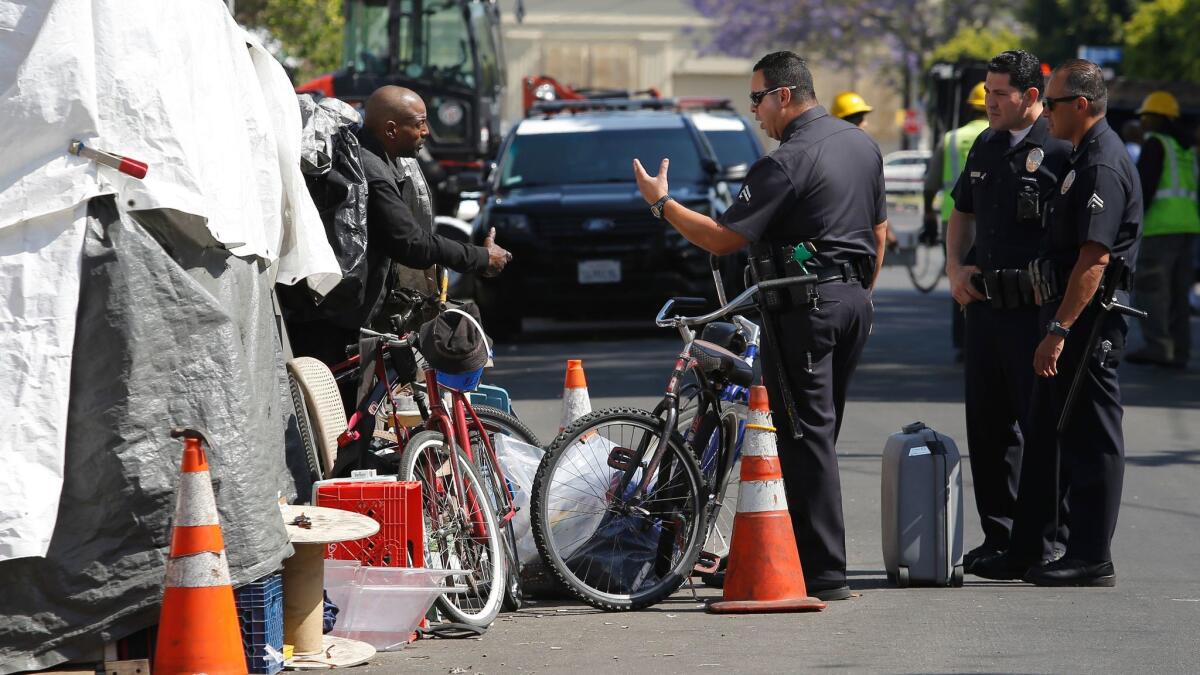
Danny Dancy was sitting glumly on a curb off Slauson Avenue in South L.A. near the encampment where he’d been staying for months. Ten minutes later, a sanitation crew arrived to clear the sidewalk of his belongings — the sixth such cleanup there.
“I imagine they are going to take everything,” Dancy said. “I think the money they spend could be put to a better use. It’s tough because you don’t have nowhere to go.”
But help was around the corner. Homeless outreach workers were on hand to share information about shelters and other services with street dwellers who were frustrated or confused about what to do next.
Jeremiah Diaz, an employee with the homeless outreach organization Hopics, said as the city has increased the frequency of cleanups, he has noticed that homeless residents seem more willing to accept help. During one cleanup in May on Grand Avenue in South L.A., his group persuaded three campers to move into a shelter.
“It’s kind of a strong-armed way to do it, but we are getting a lot more interest in services,” he said.
Twitter: @bposton
Twitter: @LATdoug
More to Read
Sign up for Essential California
The most important California stories and recommendations in your inbox every morning.
You may occasionally receive promotional content from the Los Angeles Times.

